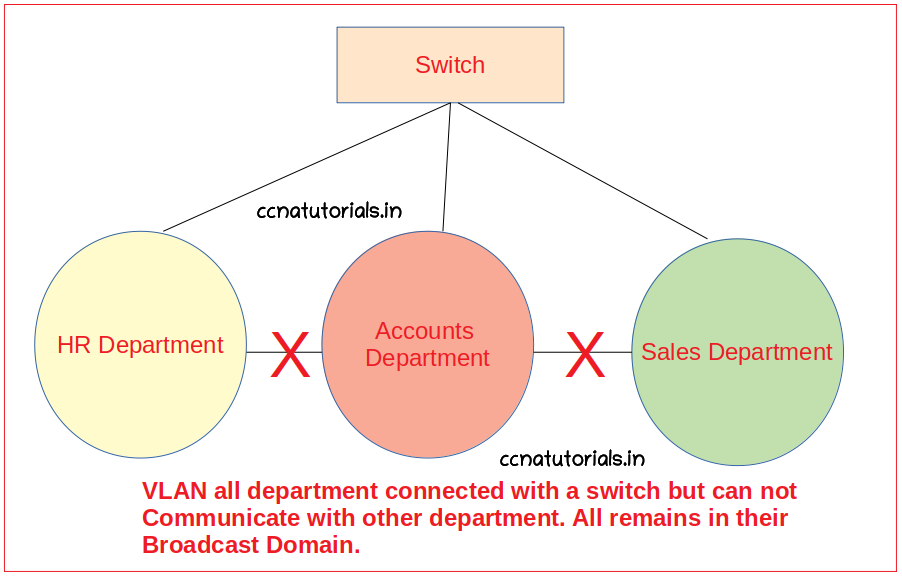In this article I describe the VLAN Identification methods of Switch for CCNA exam. VLAN provides multiple virtual networks in a physical network. We can break a local area network into multiple virtual networks. The devices of same virtual network can communicate with each other without interfere to other virtual network. The switchports of a switch can be used as access port or trunk port. The function of access port and trunk port are different. there are some predefined methods for VLAN Identification methods of Switch
The switch provide a single broadcast domain to all connected devices by default. Each port of switch creates single collision domain. VLAN breaks the broadcast domain into small broadcast domain. If we need to make communication between different VLANs then we need a router. Router have the feature to provide communication between different networks. VLAN provides the logical network within a single physical network.
some basic terms related to VLAN Identification methods of Switch
Every switchport works on separate collision domain. We can say each device connected with a switchport remains in separate collision domain. By default all switchports of a switch works in a single broadcast domain. It can be define as all the devices working in a single LAN remains in a single broadcast domain. The big network of single broadcast domain can be divided into different small broadcast domains by creating the VLANs in the network. Every VLAN have its own broadcast domain.
Breaking the large broadcast domain into small broadcast domains provides an extra layer of security in the network. The devices of different broadcast domains can not communicate with each other. The swithports can be configured to restrict the unauthorised use by unwanted devices. Management of networking devices become easier by creating VLANs. Network administrator can monitor the small network more efficiently than a large network.
Methods of adding devices in VLAN
The devices can be added in a VLAN by two methods static and dynamic. Actually we configure the switchports for access by device with these methods. Generally static method assigned to the VLANs as it is easy and secure method. In static method we add the switchports manually to a VLAN. Suppose I assign the switchport number 4 to VLAN 10. This switchport remains assigned to VLAN unless we manually change it or assign to another VLAN. By default all switchports assigned to a single VLAN. We need to assign each port manually to the required VLAN.
The other method is dynamic assignment of swithports to VLAN according to the IP address of a device or MAC address of the device. Suppose a device connected to switchport 2 and it belongs to VLAN 20. If you change the switchport of this device from 2 to 10 then the switchport 10 automatically assigned to VLAN 20 and the device will work as it was. Dynamic method works in high end switches, in normal switch we can use static methods only.
VLAN Identification methods of Switch
There are several VLAN identification methods of switch. Switchports use many functions to identify the VLAN for data packet transfer from one port to another port. Each access port of a switch belongs to a particular VLAN. By default all switch ports belongs to a common VLAN 1. Each access port receive and transmit the data packets.
VLAN identification is necessary at the time of receiving the packet. Switch ports requires to identify the VLAN to define the source VLAN of the received packet. Once the switch port identify the VLAN of received packet, it will transmit the packet to the same VLAN switchports. The destination switch port defined the physical address of connected device.
Requirement of VLAN Identification methods of switch
We should know the importance of VLAN identification before going on VLAN identification methods of switch. We know a switch by default works in a single broadcast domain. It means all data packets received at any switchport can be forwarded to any switchport of the switch. We breaks the broadcast domains by creating the VLANs in a switch. Numbers of broadcast domain are equals to the numbers of VLANs. Access ports of switch belongs to VLANs. Trunk ports of switch carry the data of multiple VLANs through it.

We takes an example of multiple VLANs in a switch. See the image above, the image shown a switch breaks into 3 VLANs. We can say now we have three different switches. When a device transmit a data packet in the network, the data packet tagged with MAC address of destination device. The switch know the mac address of devices connected with the switchports.
The data packets forwarded to the destination device according to the data table stored in IOS of switch. If there is no separate VLAN in switch. All switch ports belongs to single VLAN. No need of identification of VLAN if there is single VLAN in the switch. Three VLANs creats three virtual switches. Each VLAN function like a separate switch. The data packets transfer between the devices belongs to same VLAN. Data packet received within VLAN HR Department will forwarded to devices of VLAN HR Department only. VLAN identification is necessary to achieve this target.
Flow of a data packet within a VLAN
See the image below this paragraph to understand the flow of a data packet within a VLAN. Here PC1 and PC2 are connected with switch and belongs to VLAN 10. Database table of VLAN 10 know the IP address and MAC address of both PC. Suppose physical address of PC1 is MAC1 and IP address is IP1. Similarly physical address of PC2 is MAC2 and IP address is IP2. PC1 want to send data packets to PC2. PC1 tag the MAC address of PC2 with the data packet and forward the data packet to switchport fa0/1.

Switchport fa0/1 received the data packet and tagg a identity of VLAN 10 on it. It means the data packet received from PC1 belongs to VLAN 10. Now the switch examine the data packet to identify the destination device. Switch got the destination of data packet is MAC2 which belongs to PC2. As both PC lie in a common VLAN the data packet forwarded to switchport connected with PC2 i.e fa 0/2. Switchport fa0/2 again examine the data packet for VLAN tag and found that the data packet received within the VLAN 10. switchport fa 0/2 forwarded the data packet to PC2.
If PC2 doesn’t belongs to same VLAN then the data packet will not be forwarded to any switchport. Switch will try to forward the data packet to a gateway. Here in this network there is no any gateway. A router is require to transfer the data packets between different VLANs. The process of data packet forwarding between different VLANs is known as Inter VLAN Routing. In this article we explain the process of data packets flow within a single VLAN. You can imagine data packets flow within a single VLAN can not be possible without identification of VLAN.
ISL Inter Switch Link Protocol for VLAN identification of switch
Inter Switch Link Protocol is a method for tagging the VLAN information on a Ethernet Frame. Inter Switch Link Protocol allow multiplexing of multiple VLAN frame on a particulate Ethernet port. This port works like a trunk port. The facility of multiplexing VLAN frame allow communication between different switches via trunk ports. You can assume multiple switches like a single switch by running ISL protocol. ISL protocol keep the data frames separate from each other by tagging the vlan information on them.
ISL inter switch link protocol does not alter the original frame. The ISL encapsulate a 26 byte additional ISL header on the frames. This 26 byte header is the identity of each data frame VLAN. Another frame check sequence (FCS) tag also added on each frame to keep the frames in a sequence. Data packets transfers between same VLAN in different switches without any router. This technology reduces the latency in the network.
I hope you enjoy and understood the importance of identification of VLAN by the switch so the data packet can be forwarded to correct destination device. For any query or suggestion on this article you may contact us or drop a comment below. Your suggestions are always welcome by us.






